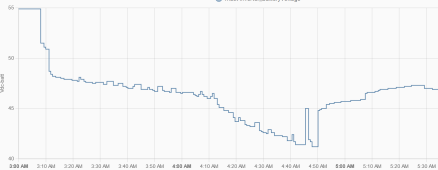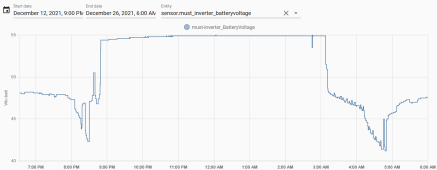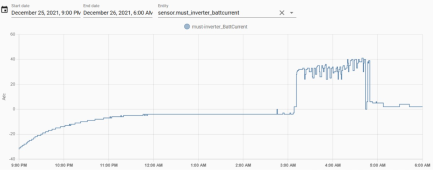Hello everyone,
We've had a local company install a solar system for us and it has been working great. I have a concern though about running the AC in heater mode. We're running two banks of 4 batteries, each battery is a tubular 12V/240AH. The inverter is a 5.2KW 48V 230V inverter (we use 220V where I live, 50Hz)
I have a victron smartshunt and I have my inverter connected to home assistant to log the data. I ran the AC in heater mode (~1500Watts) and it ran for 2 hours before the inverter cut off due to low voltage, from 3AM (prior to that the grid was available) to approximately 5AM:

Is this drop in voltage normal? Total home power usage was around 1700Watts, less than 50% the inverter capabilities. it happened twice before I woke up and turned off the heater at 4:50AM. Then without the load the voltage kept recovering. Victron SmartShunt was showing an SoC of 88% around that time.
I am aware under load the voltage drops, but then again state of charge is at 88%, way higher than the 50% I try to stay above as those are flooded lead acid batteries. What am I missing here?
This is my first post, so I apologize in advance if I broke any rules or posted in the wrong place.
- Michel
We've had a local company install a solar system for us and it has been working great. I have a concern though about running the AC in heater mode. We're running two banks of 4 batteries, each battery is a tubular 12V/240AH. The inverter is a 5.2KW 48V 230V inverter (we use 220V where I live, 50Hz)
I have a victron smartshunt and I have my inverter connected to home assistant to log the data. I ran the AC in heater mode (~1500Watts) and it ran for 2 hours before the inverter cut off due to low voltage, from 3AM (prior to that the grid was available) to approximately 5AM:

Is this drop in voltage normal? Total home power usage was around 1700Watts, less than 50% the inverter capabilities. it happened twice before I woke up and turned off the heater at 4:50AM. Then without the load the voltage kept recovering. Victron SmartShunt was showing an SoC of 88% around that time.
I am aware under load the voltage drops, but then again state of charge is at 88%, way higher than the 50% I try to stay above as those are flooded lead acid batteries. What am I missing here?
This is my first post, so I apologize in advance if I broke any rules or posted in the wrong place.
- Michel






